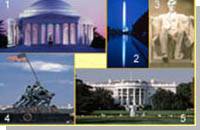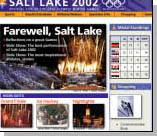|  They told him to quit, that he wasn’t good enough, but figure skater Paul Wylie refused to listen. They told him to quit, that he wasn’t good enough, but figure skater Paul Wylie refused to listen.
 When he stepped off the plane in Washington, D.C.1, following the 1992 Winter Games, and
everyone in the terminal started clapping, Paul Wylie almost stopped in his tracks. Who’ s behind me?
He wondered. Despite the silver medal in his pocket, he couldn’t believe that the applause was for
him. From that moment on, Paul recognized that his life would never be the same. When he stepped off the plane in Washington, D.C.1, following the 1992 Winter Games, and
everyone in the terminal started clapping, Paul Wylie almost stopped in his tracks. Who’ s behind me?
He wondered. Despite the silver medal in his pocket, he couldn’t believe that the applause was for
him. From that moment on, Paul recognized that his life would never be the same.

 The silver medal he earned in Albertville, France, ushered the 27-year-old figure skater into a new
existence. He was no longer a nobody who choked at big events, like the 1988 Calgary Olympics,
where he finished an unimpressive 10th. No longer the recipient of advice from judges who, after
Paul’s performance in the ’91 World Championships, suggested that he quit: “Make room for the
younger skaters.” The silver medal he earned in Albertville, France, ushered the 27-year-old figure skater into a new
existence. He was no longer a nobody who choked at big events, like the 1988 Calgary Olympics,
where he finished an unimpressive 10th. No longer the recipient of advice from judges who, after
Paul’s performance in the ’91 World Championships, suggested that he quit: “Make room for the
younger skaters.”

 No longer the target of loaded questions from reporters covering the ’91 Olympic Trials (“What
are you doing here?”). No longer the skater incapable of finishing ahead of U.S. National Champion
Todd Eldredge or three-time defending World Champion Kurt Browning of Canada. No longer the target of loaded questions from reporters covering the ’91 Olympic Trials (“What
are you doing here?”). No longer the skater incapable of finishing ahead of U.S. National Champion
Todd Eldredge or three-time defending World Champion Kurt Browning of Canada.

 Now Paul Wylie was an Olympic hero. An athlete who kept going when doubters suggested he
quit. A recent Harvard University graduate who had frequently fantasized about life without grueling hours on the ice, but who persevered anyway. A young man who had discovered and demonstrated
that goals can be reached no matter how many obstacles and botched attempts lie in the way. Now Paul Wylie was an Olympic hero. An athlete who kept going when doubters suggested he
quit. A recent Harvard University graduate who had frequently fantasized about life without grueling hours on the ice, but who persevered anyway. A young man who had discovered and demonstrated
that goals can be reached no matter how many obstacles and botched attempts lie in the way.

 “A reporter who interviewed me at the Closing Ceremonies told me, ‘You came here an unknown
and now you go home a hero,’ Paul says. “I thought that was interesting, because I was in France and
unaware of how my journey was unfolding on U.S. television. It wasn’t until I stepped off the plane that
I realized people considered me a hero. They were changed by my story. They were changed by the
fact that I was able to persevere and win the silver medal even though almost everyone had counted
me out.” “A reporter who interviewed me at the Closing Ceremonies told me, ‘You came here an unknown
and now you go home a hero,’ Paul says. “I thought that was interesting, because I was in France and
unaware of how my journey was unfolding on U.S. television. It wasn’t until I stepped off the plane that
I realized people considered me a hero. They were changed by my story. They were changed by the
fact that I was able to persevere and win the silver medal even though almost everyone had counted
me out.”

 At times, Paul had almost counted himself out. “Two months before the ’92 Olympics, USA Today2 did a survey of different athletes and asked, ‘How often do you contemplate retirement?’ The choices were: ‘yearly,’ ‘monthly’ or ‘weekly.’” At times, Paul had almost counted himself out. “Two months before the ’92 Olympics, USA Today2 did a survey of different athletes and asked, ‘How often do you contemplate retirement?’ The choices were: ‘yearly,’ ‘monthly’ or ‘weekly.’” 
 “I wrote, ‘daily,’ because it was hard to keep going. But I just decided, I’m going to persevere and hang in there, because I have a shot.” “I wrote, ‘daily,’ because it was hard to keep going. But I just decided, I’m going to persevere and hang in there, because I have a shot.” 
 Things definitely changed in 1992 in Albertville. “To have my story be one that brought tears to people’s eyes, because of the way it turned around — that changed my life as well,” Paul says. “I looked at my skating career and saw it rewritten and beautiful, as opposed to a big disappointment and many years struggling toward some goal but not reaching it.” Things definitely changed in 1992 in Albertville. “To have my story be one that brought tears to people’s eyes, because of the way it turned around — that changed my life as well,” Paul says. “I looked at my skating career and saw it rewritten and beautiful, as opposed to a big disappointment and many years struggling toward some goal but not reaching it.” 
 With medal in hand, Paul was suddenly ushered into a world of lucrative endorsements and figure-skating world tours, of exclusive events and autograph seekers. Everything you might expect of a celebrity hero, but none of what Paul himself believes merits the honor of that title. With medal in hand, Paul was suddenly ushered into a world of lucrative endorsements and figure-skating world tours, of exclusive events and autograph seekers. Everything you might expect of a celebrity hero, but none of what Paul himself believes merits the honor of that title. 
 “What makes a true hero is selfless service,” he says. “Or someone whose life and actions inspire
you to be better and to be a bigger person. I don’t think what I did was selfless service. But God used
the story of my life to inspire others.” “What makes a true hero is selfless service,” he says. “Or someone whose life and actions inspire
you to be better and to be a bigger person. I don’t think what I did was selfless service. But God used
the story of my life to inspire others.”

 Heroism, Paul has observed, requires daily maintenance. Just as a skater achieves perfection by
practising small parts of his larger routine day after day, a hero must look for ways to serve on a regular
basis — not just in a crisis or more visible situation. Heroism, Paul has observed, requires daily maintenance. Just as a skater achieves perfection by
practising small parts of his larger routine day after day, a hero must look for ways to serve on a regular
basis — not just in a crisis or more visible situation.

 As an Olympic medal loses its luster after years of storage, a hero will lose his credibility if he
stops looking to the needs of others. When Paul joins the thousands of others watching the Olympics
in Salt Lake City3, he knows that behind the scenes of each victory, of each record-setting finish, stand
countless stories of everyday heroes. Heroes who refuse to give up.
As an Olympic medal loses its luster after years of storage, a hero will lose his credibility if he
stops looking to the needs of others. When Paul joins the thousands of others watching the Olympics
in Salt Lake City3, he knows that behind the scenes of each victory, of each record-setting finish, stand
countless stories of everyday heroes. Heroes who refuse to give up. 
(707
words)
Notes:
1. Washington, D.C: Washington, D.C. is the capital of the United States of America. The city of Washington has the same boundaries as the District of Columbia (D.C.), a federal territory established in 1790 as the site of the new nation’s permanent capital.
2. USA Today: USA Today is a modern newspaper for articles about the USA and its culture. Every day, subscribers receive 20 – 25 articles on Trends Across the USA, News, Money, Entertainment, Life and Health, Sports and Opinion.
3. Salt Lake City: Salt Lake City is the capital city of Utah and seat of Salt Lake County, located in the northern part of the state on the Jordan River. The 2002 Winter Olympics were held in Salt Lake City.
↑TOP
|



 Todd
Eldrege is a World Champion and six-time World medallist. He is a six-time
U.S. National Champion and a three time Olympian. Before the 2002 Games
concluded, Todd officially announced his retirement from Olympic skating.
With this announcement, Todd's eligible career has ended. At his retirement
press conference, Todd stated that his career, as a whole, has been filled
with highs and lows. He hopes that he will be remembered for working hard
to achieve his goals and persevering.
Todd
Eldrege is a World Champion and six-time World medallist. He is a six-time
U.S. National Champion and a three time Olympian. Before the 2002 Games
concluded, Todd officially announced his retirement from Olympic skating.
With this announcement, Todd's eligible career has ended. At his retirement
press conference, Todd stated that his career, as a whole, has been filled
with highs and lows. He hopes that he will be remembered for working hard
to achieve his goals and persevering.  Kurt Browning is Canada's Four Time Canadian and World
Figure Skating Champion. He is one of the most celebrated skaters in his
native country of Canada, and the world. Kurt has landed himself a spot
in the Guinness Book of World Records for being the first man to complete
a Quadruple Jump at the World Figure Skating Championships in Budapest,
Hungary on March 25, 1988.
Kurt Browning is Canada's Four Time Canadian and World
Figure Skating Champion. He is one of the most celebrated skaters in his
native country of Canada, and the world. Kurt has landed himself a spot
in the Guinness Book of World Records for being the first man to complete
a Quadruple Jump at the World Figure Skating Championships in Budapest,
Hungary on March 25, 1988.  Harvard University, a private, coeducational institution
of higher education, is based in Cambridge, Massachusetts. It is the oldest
university in the United States.
Harvard University, a private, coeducational institution
of higher education, is based in Cambridge, Massachusetts. It is the oldest
university in the United States. There’s no better daily source for articles about the
USA and its culture than syndicated features from USA TODAY, the pioneer
of modern newspapers. Every day, subscribers receive 20-25 articles on
Trends Across the USA, News, Money, Entertainment, Life and Health, Sports
and Opinion.
There’s no better daily source for articles about the
USA and its culture than syndicated features from USA TODAY, the pioneer
of modern newspapers. Every day, subscribers receive 20-25 articles on
Trends Across the USA, News, Money, Entertainment, Life and Health, Sports
and Opinion.  Salt Lake City, Utah hosts the 2002 Winter Olympic
Games starting February 8, 2002. The games lasted 17 days and featured
more than 180 events in 15 different sports.
Salt Lake City, Utah hosts the 2002 Winter Olympic
Games starting February 8, 2002. The games lasted 17 days and featured
more than 180 events in 15 different sports.